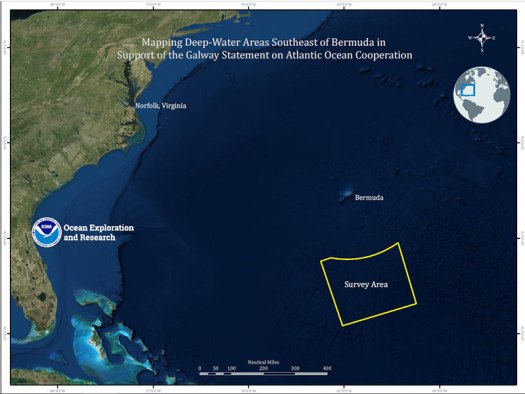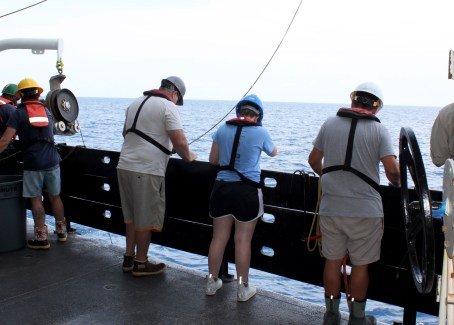NOAA Teacher at Sea
Taylor Planz
Aboard NOAA Ship Fairweather
July 9 – 20, 2018
Mission: Arctic Access Hydrographic Survey
Geographic Area of Cruise: Point Hope, Alaska and vicinity
Date: July 19, 2018 at 10:53am
Weather Data from the Bridge
Latitude: 65° 15.541′ N
Longitude: 168° 50.424′ W
Wind: 10 knots NW, gusts up to 20 knots
Barometer: 765.06 mmHg
Visibility: 8 nautical miles
Temperature: 7.4° C
Sea Surface 7.2° C
Weather: Overcast, light drizzle
Interview Issue!
NOAA hires employees with many different career specialties. So many in fact that I cannot cover them all in one blog post. In an effort to give you a glimpse into some of the day to day happenings of the ship, I chose three different people with widely varying careers to interview today. The first is Oiler Kyle Mosier, who works in the engineering department. Next is Erin Billings, a meteorologist from the National Weather Service visiting NOAA for this leg of the mission. Finally, ENS Jeffrey Calderon who works for the NOAA Commissioned Officer Corps as the Medical Person In Charge.
Oiler Kyle Mosier

What is your job on NOAA Ship Fairweather?
“I am an oiler in the engineering department, and my job is to do maintenance work and watches when we are underway. During my work day, I complete a list of maintenance items called a SAMMS list. On a given day, I might clean strainers, air supply, or air filters. We have 5 fan rooms; fan rooms 1 and 3 go to our staterooms, so I make sure those are always clean.”
What tool do you use in your work that you could not live without?
“An adjustable wrench. We use wrenches just about every day, so if I only had one wrench (and one tool) it would be the one that can adjust to many sizes.”
What do you think you would be doing if you were not working on a NOAA ship?
“My dream job is to be a successful writer. I got started in high school just writing for fun, and I got better as I went through college. I also took an art class in college, and the teacher let me work on my own project ideas. I made my first book cover in that class, for a book called “Natalie and the Gift of Life”. I brought back my original character Natalie years later because I loved that first book so much, and I’m a much better writer now versus back then. My most recent book is “Natalie and the Search for Atlantis”.”
What advice would you give to students who may be interested in a job like yours?
“Some people only get certified to be an Oiler, but I went to the Maritime Academy and got my QMED certification (Qualified Member of the Engine Department). I recommend this pathway because it qualifies you to be an electrician, oiler, junior unlicensed engineer, and work in refrigeration. You’re not stuck with one job; instead, you have many different choices for what kind of job you do.”
Erin Billings

Tell me about what you do for a living.
“I am general forecaster for the National Weather Service in Fairbanks, Alaska. I produce forecasts for northern Alaska and the adjacent waters. As an organization, we forecast for approximately 350,000 square miles of land area.”
What do you enjoy most about your work?
“It’s like putting all the pieces of a puzzle together. Forecasting is a lot about pattern recognition. People also rely a lot on forecasts, so I feel like my job is important for people as they plan their day, their weekend, and even their vacations.”
What parts of your job can be challenging?
“When you have a lot going on and the weather is frequently changing, it can be hard to choose what area gets looked at first as well as managing the time it takes to do that. I work rotating shifts as well, so my work hours are always changing and sometimes I work 7 days in a week. I love what I do though, so there’s a trade off.”
What advice would you give to students who may be interested in a job like yours?
“In order to get in to a meteorological position, you should find a way to set yourself apart from other people. Get a good foundation of science and math, but focus on something else you can bring to the table. Examples could be learning a foreign language, learning computer programming, or completing an internship or relevant volunteer position. Setting yourself apart will make you more competitive than everyone else who is applying for the same job and has the same degree as you.”
Ensign Jeffrey Calderon

What is your job on NOAA Ship Fairweather?
“I am a Junior Officer with the NOAA Commissioned Officer Corps. My job is administration of the ship, which is broken down into collateral duties. Each duty needs to be completed to keep the ship operating smoothly. I am the Medical Person in Charge, so I keep track of all the medicines, make sure they haven’t expired, order medical supplies, and inspect medical equipment. I can also perform CPR and first aid. I can follow a doctor’s order to administer medication, including IVs. I am also in charge of all of the keys on the ship; there are about 300. I have to get them back from people when they leave and make copies when needed. I am the auxiliary data manager on the ship. I collect weather data, inspect the sensors (anemometer, barometer, etc), and upload the data to an online system. I also drive and navigate the ship and the small launch boat.”
What do you enjoy most about your work?
“I like being on a ship because I get to travel and see things that I will remember all my life. On the Fairweather, I get to see the aurora borealis, mountains, fjords, whales… things that not everyone gets to see. It also forces me to face new challenges; there’s always something I have to master and learn. I may have to fight a fire on the ship or go out on a launch and rescue somebody on the water.”
What do you miss the most when you are at sea?
“I miss having a real bed. I miss the privacy too. My stateroom is a 2-person stateroom.”
What advice would you give to students who may be interested in a job like yours?
“Pick a science-related path. It will be challenging, but it will be worth it in the long run. Science degrees will better prepare you for challenging careers, and it will prove to future employers that you can persevere through challenges. NOAA is also looking for people with good moral character, so stay out of trouble.”
Question of the Day
What are the eligibility requirements to be in the NOAA Commissioned Officer Corps?
Answer to Last Question of the Day
As mentioned above, northern Alaska reaches temperatures colder than most people can even imagine! Nome’s record low temperature occurred on January 27, 1989. Without using the internet, how cold do you think Nome got on that day?
The coldest temperature on record in Nome, Alaska is -54° Fahrenheit! Brrrr!








































































